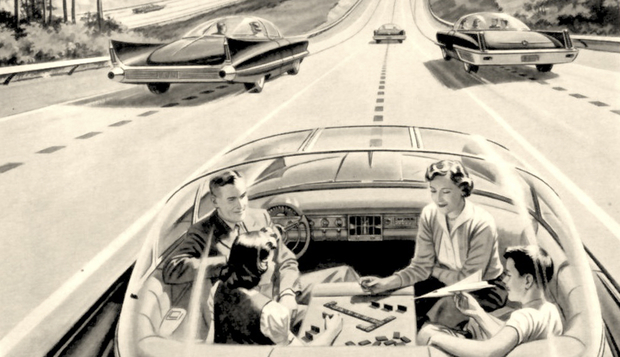In 1964, Isaac Asimov wrote an essay for the New York Times entitled, Visit the World’s Fair in 2014. The essay was a free-wheeling opinion of things to come, viewed through the lens of New York’s World’s Fair of 1964. The essay shows that even a grand master of science fiction cannot predict the future — he got some things quite right and other things rather wrong. Some examples below, and his full essay are below.
That said, what has captured recent attention is Asimov’s thinking on the complex and evolving relationship between humans and technology, and the challenges of environmental stewardship in an increasingly over-populated and resource-starved world.
So, while Asimov was certainly not a teller of fortunes, we had many insights that many, even today, still lack.
Read the entire Isaac Asimov essay here.
What Asimov got right:
“Communications will become sight-sound and you will see as well as hear the person you telephone.”
“As for television, wall screens will have replaced the ordinary set…”
“Large solar-power stations will also be in operation in a number of desert and semi-desert areas…”
“Windows… will be polarized to block out the harsh sunlight. The degree of opacity of the glass may even be made to alter automatically in accordance with the intensity of the light falling upon it.”
What Asimov got wrong:
“The appliances of 2014 will have no electric cords, of course, for they will be powered by long- lived batteries running on radioisotopes.”
“…cars will be capable of crossing water on their jets…”
“For short-range travel, moving sidewalks (with benches on either side, standing room in the center) will be making their appearance in downtown sections.”
From the Atlantic:
In August of 1964, just more than 50 years ago, author Isaac Asimov wrote a piece in The New York Times, pegged to that summer’s World Fair.
In the essay, Asimov imagines what the World Fair would be like in 2014—his future, our present.
His notions were strange and wonderful (and conservative, as Matt Novak writes in a great run-down), in the way that dreams of the future from the point of view of the American mid-century tend to be. There will be electroluminescent walls for our windowless homes, levitating cars for our transportation, 3D cube televisions that will permit viewers to watch dance performances from all angles, and “Algae Bars” that taste like turkey and steak (“but,” he adds, “there will be considerable psychological resistance to such an innovation”).
He got some things wrong and some things right, as is common for those who engage in the sport of prediction-making. Keeping score is of little interest to me. What is of interest: what Asimov understood about the entangled relationships among humans, technological development, and the planet—and the implications of those ideas for us today, knowing what we know now.
Asimov begins by suggesting that in the coming decades, the gulf between humans and “nature” will expand, driven by technological development. “One thought that occurs to me,” he writes, “is that men will continue to withdraw from nature in order to create an environment that will suit them better. “
It is in this context that Asimov sees the future shining bright: underground, suburban houses, “free from the vicissitudes of weather, with air cleaned and light controlled, should be fairly common.” Windows, he says, “need be no more than an archaic touch,” with programmed, alterable, “scenery.” We will build our own world, an improvement on the natural one we found ourselves in for so long. Separation from nature, Asimov implies, will keep humans safe—safe from the irregularities of the natural world, and the bombs of the human one, a concern he just barely hints at, but that was deeply felt at the time.
But Asimov knows too that humans cannot survive on technology alone. Eight years before astronauts’ Blue Marble image of Earth would reshape how humans thought about the planet, Asimov sees that humans need a healthy Earth, and he worries that an exploding human population (6.5 billion, he accurately extrapolated) will wear down our resources, creating massive inequality.
Although technology will still keep up with population through 2014, it will be only through a supreme effort and with but partial success. Not all the world’s population will enjoy the gadgety world of the future to the full. A larger portion than today will be deprived and although they may be better off, materially, than today, they will be further behind when compared with the advanced portions of the world. They will have moved backward, relatively.
This troubled him, but the real problems lay yet further in the future, as “unchecked” population growth pushed urban sprawl to every corner of the planet, creating a “World-Manhattan” by 2450. But, he exclaimed, “society will collapse long before that!” Humans would have to stop reproducing so quickly to avert this catastrophe, he believed, and he predicted that by 2014 we would have decided that lowering the birth rate was a policy priority.
Asimov rightly saw the central role of the planet’s environmental health to a society: No matter how technologically developed humanity becomes, there is no escaping our fundamental reliance on Earth (at least not until we seriously leave Earth, that is). But in 1964 the environmental specters that haunt us today—climate change and impending mass extinctions—were only just beginning to gain notice. Asimov could not have imagined the particulars of this special blend of planetary destruction we are now brewing—and he was overly optimistic about our propensity to take action to protect an imperiled planet.
Read the entire article here.
Image: Driverless cars as imaged in 1957. Courtesy of America’s Independent Electric Light and Power Companies/Paleofuture.

